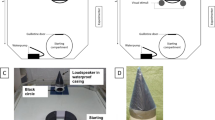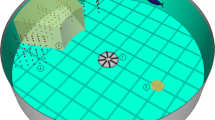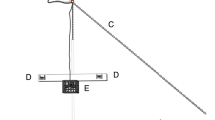Abstract
The marine environment is filled with biotic and abiotic sounds. Some of these sounds predict important events that influence fitness while others are unimportant. Individuals can learn specific sound cues and ‘soundscapes’ and use them for vital activities such as foraging, predator avoidance, communication and orientation. Most research with sounds in elasmobranchs has focused on hearing thresholds and attractiveness to sound sources, but very little is known about their abilities to learn about sounds, especially in benthic species. Here we investigated if juvenile Port Jackson sharks could learn to associate a musical stimulus with a food reward, discriminate between two distinct musical stimuli, and whether individual personality traits were linked to cognitive performance. Five out of eight sharks were successfully conditioned to associate a jazz song with a food reward delivered in a specific corner of the tank. We observed repeatable individual differences in activity and boldness in all eight sharks, but these personality traits were not linked to the learning performance assays we examined. These sharks were later trained in a discrimination task, where they had to distinguish between the same jazz and a novel classical music song, and swim to opposite corners of the tank according to the stimulus played. The sharks’ performance to the jazz stimulus declined to chance levels in the discrimination task. Interestingly, some sharks developed a strong side bias to the right, which in some cases was not the correct side for the jazz stimulus.






Similar content being viewed by others
References
Banner A (1972) Use of sound in predation by young lemon sharks, Negaprion brevirostris (Poey). Bull Mar Sci 22:251–283
Bass NC, Mourier J, Knott NA, Day J, Guttridge T, Brown C (2016) Long-term migration patterns and bisexual philopatry in a benthic shark species. Mar Freshw Res 68:1414–1421
Bates D, Mächler M, Bolker B, Walker S (2015) Fitting linear mixed-effects models using lme4. arXiv preprint. arXiv:1406.5823
Bolker BM, Brooks ME, Clark CJ, Geange SW, Poulsen JR, Stevens MHH, White J-SS (2009) Generalized linear mixed models: a practical guide for ecology and evolution. Trends Ecol Evol 24:127–135
Brainard DH (1997) The psychophysics toolbox. Spatial Vis 10:433–436
Brown C, Laland K, Krause J (2011) Fish cognition and behavior. Wiley, Oxford
Budaev S, Brown C (2011) Personality traits and behaviour. In: Brown C, Laland K, Krause J (eds) Fish cognition and behavior. Wiley-Blackwell, Oxford, p 472
Byrnes EE, Brown C (2016) Individual personality differences in Port Jackson sharks Heterodontus portusjacksoni. J Fish Biol 89:1142–1157
Byrnes EE, Vila Pouca C, Chambers SL, Brown C (2016) Into the wild: developing field tests to examine the link between elasmobranch personality and laterality. Behav 153:1777–1793
Carere C, Locurto C (2011) Interaction between animal personality and animal cognition. Curr Zool 57:491–498
Casper BM, Mann DA (2006) Evoked potential audiograms of the nurse shark (Ginglymostoma cirratum) and the yellow stingray (Urobatis jamaicensis). Environ Biol Fishes 76:101–108
Casper BM, Mann DA (2007) Dipole hearing measurements in elasmobranch fishes. J Exp Biol 210:75–81
Casper B, Mann D (2009) Field hearing measurements of the Atlantic sharpnose shark Rhizoprionodon terraenovae. J Fish Biol 75:2768–2776
Chase AR (2001) Music discriminations by carp (Cyprinus carpio). Anim Learn Behav 29:336–353
Crawford JD, Hagedorn M, Hopkins CD (1986) Acoustic communication in an electric fish, Pollimyrus isidori (Mormyridae). J Comp Physiol A 159:297–310
D’Amato MR, Salmon DP (1984) Processing of complex auditory stimuli (tunes) by rats and monkeys (Cebus apella). Anim Learn Behav 12:184–194
Dugatkin LA, Alfieri MS (2003) Boldness, behavioral inhibition and learning. Ethol Ecol Evol 15:43–49
Ferster CB, Skinner BF (1957) Schedules of reinforcement. Appleton-Century-Crofts, East Norwalk, CT, USA
Finger JS, Dhellemmes F, Guttridge TL (2017) Personality in elasmobranchs with a focus on sharks: Early evidence, challenges, and future directions. In: Vonk J, Weiss A, Kuczaj SA (eds) Personality in nonhuman animals. Springer International Publishing, Cham, pp 129–152
Gannon DP, Barros NB, Nowacek DP, Read AJ, Waples DM, Wells RS (2005) Prey detection by bottlenose dolphins, Tursiops truncatus: an experimental test of the passive listening hypothesis. Anim Behav 69:709–720
Gardiner JM, Hueter RE, Maruska KP, Sisneros JA, Casper BM, Mann DA, Demski LS (2012) Sensory physiology and behavior of elasmobranchs. Biol Sharks Relat 1:349–401
Guttridge TL, Brown C (2014) Learning and memory in the Port Jackson shark, Heterodontus portusjacksoni. Anim Cogn 17:415–425
Hart NS, Collin SP (2015) Sharks senses and shark repellents. Integr Zool 10:38–64
Hart NS, Theiss SM, Harahush BK, Collin SP (2011) Microspectrophotometric evidence for cone monochromacy in sharks. Naturwissenschaften 98:193–201
Huijbers CM, Nagelkerken I, Lössbroek PAC, Schulten IE, Siegenthaler A, Holderied MW, Simpson SD (2012) A test of the senses: fish select novel habitats by responding to multiple cues. Ecology 93:46–55
Hulse SH, Takeuchi AH, Braaten RF (1992) Perceptual invariances in the comparative psychology of music. Music Percept 10:151–184. https://doi.org/10.2307/40285605
Jordan LK, Mandelman JW, Kajiura SM (2011) Behavioral responses to weak electric fields and a lanthanide metal in two shark species. J Exp Mar Biol Ecol 409:345–350
Kelly JC, Nelson DR (1975) Hearing thresholds of the horn shark, Heterodontus francisci. J Acoust Soc Am 58:905–909
Kritzler H, Wood L (1961) Provisional audiogram for the shark, Carcharhinus leucas. Science 133:1480–1482
Ladich F (2015) Sound communication in fishes. Animal signals and communication series, vol. 4. Springer, Vienna
Ladich F, Myrberg A (2006) Agonistic behavior and acoustic communication. Commun Fish 1:121–148
Last PR, Stevens JD (2009) Sharks and rays of Australia. CSIRO Publishing, Australia, 644p
Lefcheck JS (2016) piecewiseSEM: piecewise structural equation modelling in r for ecology, evolution, and systematics. Methods Ecol Evol 7:573–579
Mann DA, Lu Z, Popper AN (1997) A clupeid fish can detect ultrasound. Nature 389:341–341
McFarland W (1990) Light in the sea: the optical world of elasmobranchs. J Exp Zool 256:3–12
Meyer CG, Holland KN, Papastamatiou YP (2005) Sharks can detect changes in the geomagnetic field. J R Soc Interface 2:129–130
Myrberg AA Jr, Ha SJ, Walewski S, Banbury JC (1972) Effectiveness of acoustic signals in attracting epipelagic sharks to an underwater sound source. Bull Mar Sci 22:926–949
Myrberg AA Jr, Mohler M, Catala JD (1986) Sound production by males of a coral reef fish (Pomacentrus partitus): its significance to females. Anim Behav 34:913–923
Myrberg AA (2001) The acoustical biology of elasmobranchs. Environ Biol Fishes 60:31–46
Nakagawa S, Schielzeth H (2010) Repeatability for Gaussian and non-Gaussian data: a practical guide for biologists. Biol Rev Camb Philos Soc 85:935–956
Nakagawa S, Schielzeth H (2013) A general and simple method for obtaining R2 from generalized linear mixed-effects models. Methods Ecol Evol 4:133–142
Nelson DR (1967) Hearing thresholds, frequency discrimination, and acoustic orientation in the lemon shark, Negaprion brevirostris (Poey). Bull Mar Sci 17:741–768
Nelson DR, Johnson RH (1972) Acoustic attraction of Pacific reef sharks: effect of pulse intermittency and variability. Comp Biochem Physiol Part A Physiol 42:85–95
Porter D, Neuringer A (1984) Music discriminations by pigeons. J Exp Psychol Anim Behav Process 10:138
Powter DM, Gladstone W (2009) Habitat-mediated use of space by juvenile and mating adult Port Jackson sharks, Heterodontus portusjacksoni, in Eastern Australia. Pac Sci 63:1–14
R Core Team (2016). R: a language and environment for statistical computing. R Foundation for Statistical Computing, Vienna
Radford C, Stanley J, Simpson S, Jeffs A (2011) Juvenile coral reef fish use sound to locate habitats. Coral Reefs 30:295–305
Remage-Healey L, Nowacek DP, Bass AH (2006) Dolphin foraging sounds suppress calling and elevate stress hormone levels in a prey species, the Gulf toadfish. J Exp Biol 209:4444–4451
Richardson WJ, Greene CR Jr, Malme CI, Thomson DH (2013) Marine mammals and noise. Academic Press, San Diego
Ryan LA, Hart NS, Collin SP, Hemmi JM (2016) Visual resolution and contrast sensitivity in two benthic sharks. J Exp Biol 219:3971–3980
Scheipl F, Greven S, Küchenhoff H (2008) Size and power of tests for a zero random effect variance or polynomial regression in additive and linear mixed models. Comput Stat Data Anal 52:3283–3299
Schielzeth H, Nakagawa S (2013) rptR: repeatability for Gaussian and non-Gaussian data. R package version 0.6. 405/r52
Schluessel V (2015) Who would have thought that ‘Jaws’ also has brains? Cognitive functions in elasmobranchs. Anim Cogn 18:19–37
Shettleworth SJ (2010) Cognition, evolution, and behavior. Oxford University Press, Oxford
Sih A, Del Giudice M (2012) Linking behavioural syndromes and cognition: a behavioural ecology perspective. Philos Trans R Soc B Biol Sci 367:2762–2772
Simpson SD, Meekan M, Montgomery J, McCauley R, Jeffs A (2005) Homeward Sound. Science 308:221–221
Simpson SD, Meekan MG, Larsen NJ, McCauley RD, Jeffs A (2010) Behavioral plasticity in larval reef fish: orientation is influenced by recent acoustic experiences. Behav Ecol 21:1098–1105
Slabbekoorn H, Bouton N, van Opzeeland I, Coers A, ten Cate C, Popper AN (2010) A noisy spring: the impact of globally rising underwater sound levels on fish. Trends Ecol Evol 25:419–427
Spedicato GA, Kang TS, Yalamanchi SB, Yadav D (2016) The markovchain package: a package for easily handling Discrete Markov Chains in R. https://cran.r-project.org/web/packages/markovchain/markovchain.pdf. Accessed 6 Nov 2017
Trompf L, Brown C (2014) Personality affects learning and trade-offs between private and social information in guppies, Poecilia reticulata. Anim Behav 88:99–106
Tyack P (1998). Acoustic communication under the sea. Hopp SL, Owren MJ, Evans CS (eds) Animal acoustic communication. Springer, New York, pp 163–220
Watanabe S, Sato K (1999) Discriminative stimulus properties of music in Java sparrows. Behav Proc 47:53–57
White S, Wagner T, Gowan C, Braithwaite V (2016) Can personality predict individual differences in brook trout spatial learning ability? Behav Process 414:220–228
Wilson M, Acolas M-L, Bégout M-L, Madsen PT, Wahlberg M (2008) Allis shad (Alosa alosa) exhibit an intensity-graded behavioral response when exposed to ultrasound. J Acoust Soc Am 124:EL243-EL247
Zion B, Barki A (2012) Ranching fish using acoustic conditioning: has it reached a dead end? Aquaculture 344–349:3–11
Zion B, Karplus I, Barki A (2010) Generalization and discrimination of positive and negative acoustic stimuli in the common carp (Cyprinus carpio). Behav Process 83:306–310
Zuur A, Ieno E, Walker N, Saveliev A, Smith G (2009) Mixed effects models and extensions in ecology with R. Springer, New York
Acknowledgements
This research was funded by the Department of Biological Sciences at Macquarie University, and CVP was supported by an Endeavour Postgraduate (PhD) Scholarship. We thank the members and interns of the Fish Lab and SIMS for husbandry assistance, Jack Gruber for help running the experiment, Drew Allen for advice on statistical analysis, and Vera Schlüessel and two anonymous reviewers for their insightful comments.
Author information
Authors and Affiliations
Corresponding author
Ethics declarations
Conflict of interest
The authors declare they have no conflict of interest.
Ethical approval
All applicable international, national, and/or institutional guidelines for the care and use of animals were followed. This work was approved by the Macquarie University Animal Ethics Committee under ARA 2014-003.
Electronic supplementary material
Below is the link to the electronic supplementary material.
Rights and permissions
About this article
Cite this article
Vila Pouca, C., Brown, C. Food approach conditioning and discrimination learning using sound cues in benthic sharks. Anim Cogn 21, 481–492 (2018). https://doi.org/10.1007/s10071-018-1183-1
Received:
Revised:
Accepted:
Published:
Issue Date:
DOI: https://doi.org/10.1007/s10071-018-1183-1




